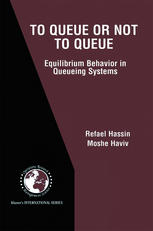

Most ebook files are in PDF format, so you can easily read them using various software such as Foxit Reader or directly on the Google Chrome browser.
Some ebook files are released by publishers in other formats such as .awz, .mobi, .epub, .fb2, etc. You may need to install specific software to read these formats on mobile/PC, such as Calibre.
Please read the tutorial at this link: https://ebookbell.com/faq
We offer FREE conversion to the popular formats you request; however, this may take some time. Therefore, right after payment, please email us, and we will try to provide the service as quickly as possible.
For some exceptional file formats or broken links (if any), please refrain from opening any disputes. Instead, email us first, and we will try to assist within a maximum of 6 hours.
EbookBell Team

5.0
110 reviewsThe literature on equilibrium behavior of customers and servers in queuing systems is rich. However, there is no comprehensive survey of this field. Moreover, what has been published lacks continuity and leaves many issues uncovered. One of the main goals of this book is to review the existing literature under one cover. Other goals are to edit the known results in a unified manner, classify them and identify where and how they relate to each other, and fill in some gaps with new results. In some areas we explicitly mention open problems. We hope that this survey will motivate further research and enable researchers to identify important open problems. The models described in this book have numerous applications. Many examples can be found in the cited papers, but we have chosen not to include applications in the book. Many of the ideas described in this book are special cases of general principles in Economics and Game Theory. We often cite references that contain more general treatment of a subject, but we do not go into the details. we have highlighted the results For each topic covered in the book, that, in our opinion, are the most important. We also present a brief discussion of related results. The content of each chapter is briefly de scribed below. Chapter 1 is an introduction. It contains basic definitions, models and solution concepts which will be used frequently throughout the book.